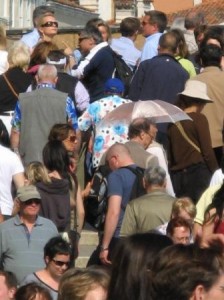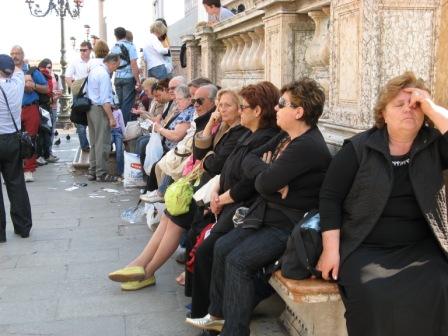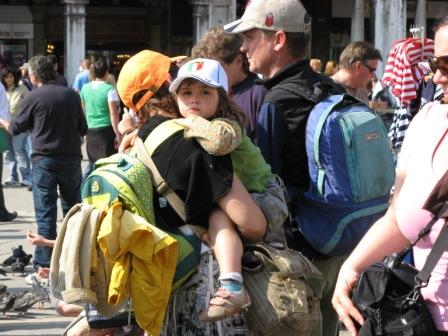There’s so much to say about tourism in Venice I’ll have to go in easy stages, filling many pages and posts. Let’s start with last weekend, which demonstrated the rough outlines of what the term “tourism” can mean here.
The first of May is a holiday in much of Europe, its version of Labor Day in which we celebrate workers and excoriate employers.

Nothing quite so simple anymore as sending armies and tanks marching across Red Square; this year saw mass demonstrations of angry workers (and ex-workers) in Greece, France, Turkey, Spain, and Germany, and even Russia, which once reveled more in its military parades than rallies of irate trade unions.
Here in Venice, it was just another day in the march of money, and in fact there are plenty of days you could label “mayday mayday,” when holidaying legions of tourists from all over Europe march across the city. So far this year the Horde-Meter has registered Carnival, followed by Easter weekend, then by April 25 (which fell on a weekend this year), and finally May 1.
There were roughly 60,000 tourists per day, instantly doubling the city’s population, shuffling along the narrow streets, overwhelming the Piazza San Marco, and turning the vaporettos (when and if you finally managed to get on one) into something from the Pushkar Camel Fair. Hundreds of tourist coaches unleashed their day-tripping multitudes onto a city whose only public space, the Piazza San Marco, is 320 times smaller than Red Square. Let’s put it another way: The Piazza covers 255 square meters, and crowd-density experts estimate that one square meter can reasonably (we’ll leave some latitude for what that means) hold 3-4 people. That means that ideally there would be no more than 1,000 people in the Piazza at any given time. Let’s say that the crowds peak at noon, and let’s say that that amounts to 40,000 people. Or even 30,000, half the daily total. Or even 20,000, one-third the daily total. Numbers aren’t my strongest point but I think I could already have guessed that there might be as much as 20 times more people in the Piazza than would be pleasant.
The ACTV added three runs per hour to its already heavy Grand Canal vaporetto schedule (reaching a total of 37 extra runs), as well as nine extra runs to Murano and Burano and 13 extra back to Venice. But it’s never enough, in the sense that “enough” would mean no waiting, no crushing, no delays. 
If you look at tourism in Venice in strictly logistical terms, you can see that it’s a fascinating little problem, which so far has defeated solution. There are approximations of functionality (more vaporettos), but essentially there is no way in which a city which covers only three square miles can prevent or neutralize the stress caused by this particular kind of mass demonstration. It can only be minimized, sort of.
I spent an hour in the Piazza and I came away with one unexpected insight: It’s entirely possible that the gondoliers at the two “stations” (stazi) there were not born crazy. I’ve always wondered about that. I believe it’s likely that they have been made to go crazy by too many days like this. And don’t think all these tourists represent wallets on the hoof. An inverse ratio between quantity and quality has been noticed by almost everyone, something I’ll go into on another occasion.

